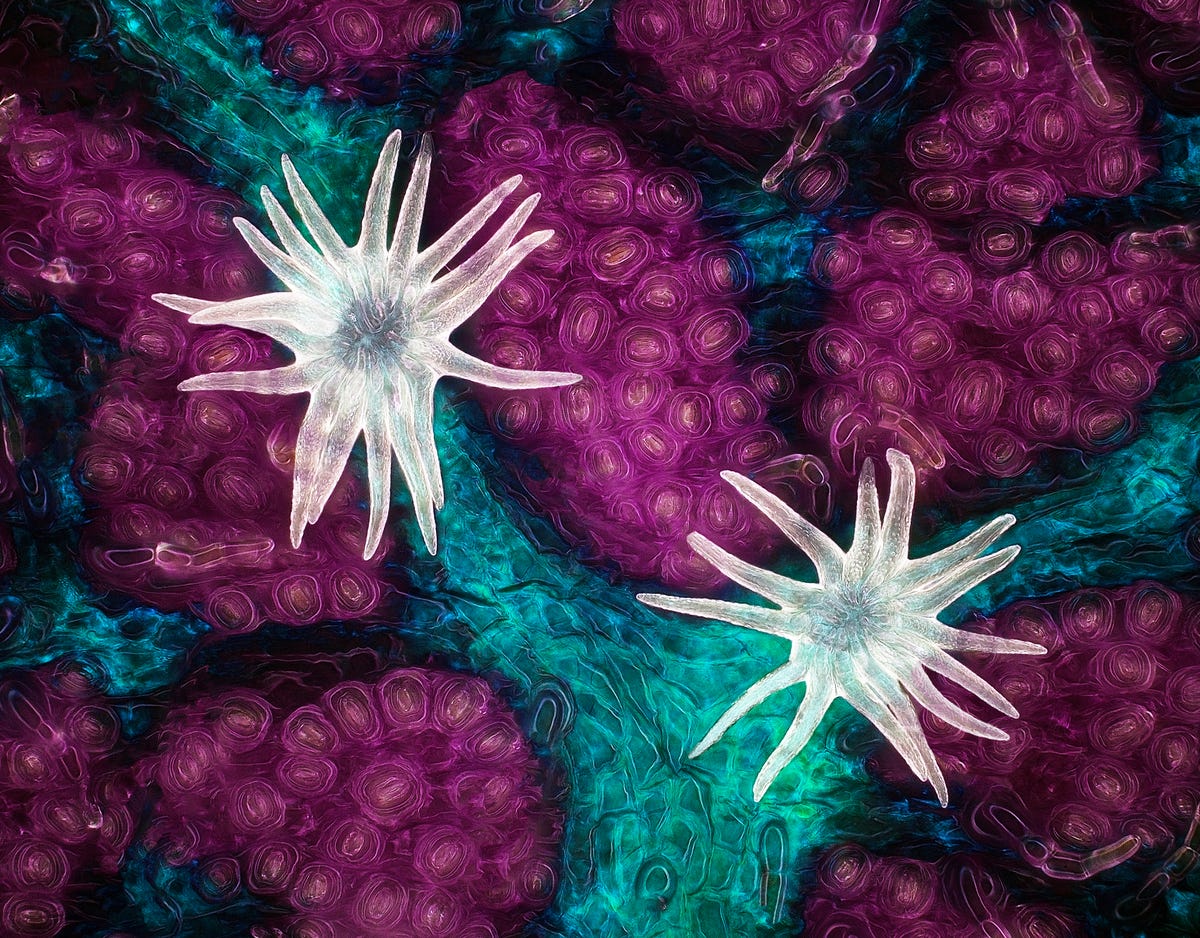Nikon's Small World Photography winners see art in remarkable, tiny worlds
Here are the top 20 photos from a contest that turns its eye to magnificent miniature worlds.

Fancy oak leaf
Bet you didn't know an oak tree hanging out in your backyard could be this fancy. Jason Kirk, who won first place in Nikon's Small World Photomicrography competition, used a custom-made microscope to image a southern oak's stomata and vessels in deep violet and cyan. Scroll through the gallery for more remarkable images
Game of Thrones should've looked like this
Anyone else wish that Game of Thrones' lighting department made the Battle of Winterfell look like these neurons?
The stunning second-place photo by Esmeralda Paric and Holly Stefan is a microfluidic device that contains 300,000 networking neurons, or brain cells. Bridged by delicate lines, axons that help neurons transmit electrical signals, each side's vibrant tones starkly contrast over a black inky liquid.
Stark-ly.
Pirate parasite
Look. At. That. Claw. Frank Reiser only magnified this parasitic insect, a louse, five times to get its magical-looking weapon this big, and that fact is mildly worrisome.
Disco neuron
Yes, there are creatures that look like this under the sea, but this is Paula Diaz's depiction of a mouse's sensory neuron. She used fluorescence to make this cell ready for a glow stick party. The image took fourth place.
Just your average housefly
Welcome to your new nightmare. Here we have a housefly that Stranger Things' creepy monster was definitely based on. Photographer Oliver Dum captured the magnified proboscis -- the long nose-like thing flies sort of drink liquid with -- of a type of fly that likely lives somewhere in your house.
Tangled forest of vessels
Spiderwebs or winter wonderland? Andrea Tedeschi offers a new perspective of an adult mouse brain's 3D vasculature in his sixth-place image. These snowy-looking branches could pass as a stop on the path to the North Pole or the aftermath of Spider-Man experimenting with his powers.
Beautiful yet deadly tick
Cobalt blue bacteria? Star supernova? Nope. Tong Zhang and Paul Stoodley present the head of a tick, a pesky little insect that equally terrorizes puppies and humans.
Magic eye intestine
Ever have one of those books where you can focus your eyes to reveal a 3D picture? Unfortunately, you won't find a solution in this photo. Amy Engevik won for her eighth-place image of a mouse intestine. I'm starting to think mice are really the star of the show here.
Kinda cute flea
The feathery, dusty rose water flea captured by ninth-place winner Jan van IJken is carrying embryos and peritrichs, a type of protozoan. Its spiky hands make it look like it's gently swimming forward, and let's be honest, this would make a killer graphic for an indie album cover.
Tinkerbell's butterfly neighborhood
OK, wow. Sébastien Malo's remarkable winning photo of a butterfly wing makes me believe fairies exist. The darker vein surrounded by translucent, yellow, feathery scales marvelously resemble a Pixar animation.
Mouse retina or inside of a black hole?
I'm pretty sure if I didn't tell you this was a high-definition magnification of a mouse's retina, you'd believe it's a Radiohead album.
The longer you stare at this 11th place photo by Jason Kirk and Carlos P. Flores Suarez, the more movement you begin to feel. The curvature of the reddish edges are even reminiscent of a black hole's event horizon.
Bubble buddy
Remember Spongebob's friend bubble buddy? This fun and blobby thing is actually a breast organoid. The blue parts are myoepithelial cells "crawling" on the crimson breast cells. The striking black background in Jakub Sumbla's photograph really emphasizes the organoid's shape, highlighting the few powdery specks of cells falling away from the cluster. Also, check out that swirly cyan hole toward the bottom.
Your T-shirt looks like this
Felice Placenti reintroduces cotton with this 10x magnified photo of the fabric. The dreamlike gradient that flows from soft orange to pearly white seems to emphasize the light source Placenti used. Those yellow spheres, believe it or not, are pollen.
What Christmas ornaments strive to be
Joern N. Hopke captures crystal clear symmetry, courtesy of mother nature, in this winning photo. It's hard to believe every single snowflake that falls from the sky is as beautiful as this one.
Da Vinci would have wanted this algae
Bernard Allard's photograph of a diatom, single-celled algae belongs alongside the detailed sketches in the Metropolitan Museum of Art. Its fractal-esque pattern resembles some of Da Vinci's works, and I can't help but compare the central lines with chromosomes lined up during mitosis.
Neuronal lightning bolts
Some astronauts who lived on the International Space Station have related lightning during a thunderstorm to neurons in the brain. They say each bolt looks connected as it provokes more strikes across the globe. Ruohan Zhong's photograph of the neurons surrounding the mouth and tentacles of a sea anemone illustrates that thought, perfectly.
COVID's friendly cousin
Coronavirus might be an evil twin. This image by Martin Kaae Kristiansen looks a lot like a Jackson Pollock, with its navy scribbles of cyanobacteria on a greenish pink gelatinous matrix.
Literally, just salt
Even salt can be breathtaking. Saulius Gugis magnified our tasty, tiny rocks by 10 times to reveal this chalky, vivid and maze-like picture of a salt crystal. As orange and blue are complementary colors, the eye-catching contrast in this image is spectacular.
Matrix vibes
Calcite crystals might be giving diamonds a run for their money. Billie Hughes' lavender-toned photo of the crystal suspended in a gemstone could inspire next year's Cartier showcase. The glittering light toward the left side highlights the crystal's striations so wonderfully.
Slime mold trees
Trees of this shape speckled Willy Wonka's world. But unlike his candy cane branches, this one is definitely not edible -- Alison Pollack artistically depicts slime mold in this image that took 20th place. Who knew slime has an iridescent layer?

